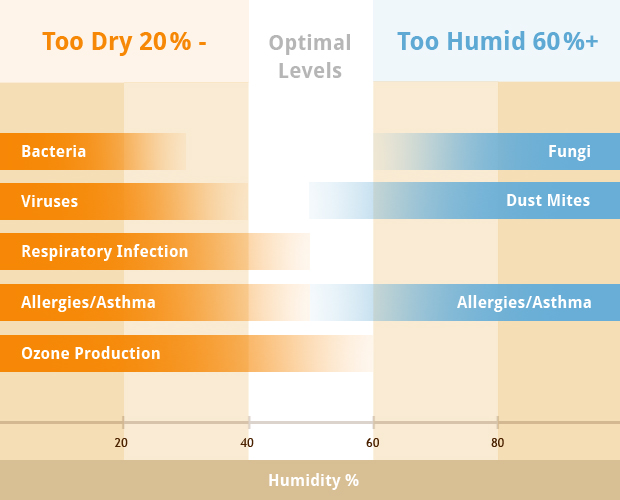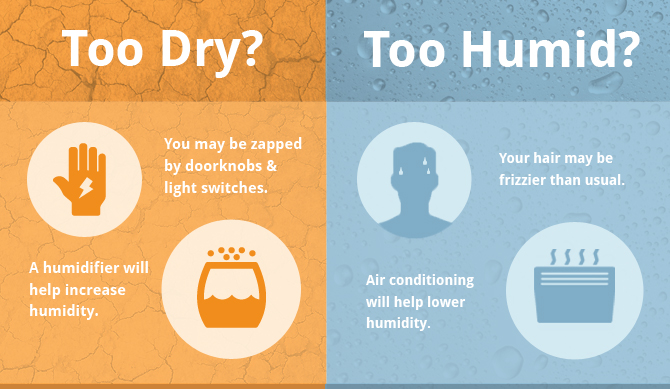Regardless of the climate you live in, indoor humidity can significantly affect your comfort and property. Therefore, managing humidity during all seasons should be a priority for all homeowners.
Recommended Humidity Level is 50%
Below you will learn best ways to maintain indoor humidity and much more.
- The Basics of Indoor Humidity
- What is the Good House Humidity Level?
- Why is it Important to Maintain the Recommended Indoor Humidity Levels?
- How to Maintain Indoor Humidity Levels
The Basics of Indoor Humidity
Humidity refers to the water vapor contained in the air around you. The term “relative humidity” is commonly used to refer to the quantity of water vapor in indoor air.
Relative humidity is the quantity of water vapor present in the air at a particular temperature in comparison to the total capacity of vapor that the air can possibly hold at that temperature. It’s expressed as a percentage.
For example, when the air contains the maximum amount of water vapor that it’s capable of holding at a certain temperature, then the relative humidity is at 100%. The relative humidity will be 50% if the air contains only half the amount of vapor that it can hold at the current temperature.
As temperatures increase or decrease, the capacity of water vapor that the air can hold also changes.
What is the Ideal Indoor Humidity Level?
The indoor humidity level at which people feel most comfortable depends on the level of physical activity, clothing, and personal preferences.
Generally, maintaining the relative indoor humidity between 40% and 60% is highly recommended, with the ideal level being around 50%. Anything below 30% is taken to be too dry whereas anything above 60% is regarded as too high.
Maintaining the right indoor humidity level is of particular importance to people living in areas that experience drastic changes from one season to the next. Warm air can hold more water vapor than cool air. For that reason, high humidity is nearly inevitable in the summer months.
Experts recommend keeping the indoor humidity levels above 40% but below 60% during the summer & between 40% to 50% during winter.

Humidity levels drop in the winter because cold air retains less moisture than warmer air. Therefore, air tends to be dry.
The recommended level of indoor humidity in the wintertime is between 40% and 50%. That helps prevents condensation on surfaces like windows in colder climates. However, people living in moderate climates should ideally not aim for anything lower than 40%.
In extreme cases, where the outside temperatures drop to 10˚F, you should lower the humidity indoors to between 20% and 30%. If the outdoor temperatures are between -10˚F and 0˚F, indoor humidity levels shouldn’t be more than 25%. They shouldn’t exceed 20% when the outside temperatures are between -20˚F and -10˚F.When the outside temperatures are -20˚F or lower, the humidity indoors shouldn’t be more than 15%.
Why Maintain Indoor Humidity Levels?
Indoor air usually becomes dry when the outdoor humidity levels are low, which typically occurs in the colder seasons. As you turn to your furnace to warm up your home, the conditions inside become even drier.
That’s because the heating system creates hot air through combustion, which burns out most of the existing water vapor. Your home’s humidity levels can even fall to 10% in cold conditions. Some of the problems that occur when humidity is too low include:
- Health problems: Low humidity can cause mucous membranes to dry out, increase susceptibility to colds and other respiratory illnesses, and allow germs and viruses to thrive. It can aggravate allergy and asthma symptoms. Dry air can also lead to dry skin, hair, and lips.
- General discomfort: With dry air, the body feels colder despite the warm temperatures indoors. That’s because the air draws body moisture from the skin, making you feel chilly even at high thermostat settings. As a result, you’re forced to increase the temperature to feel more comfortable, using more energy and increasing your energy bills. Low humidity can also increase the instances of annoying electric shocks at home due to static electricity.
- Damage to property: Dry air harms hardwood floors and furniture as it draws out the moisture from the wood, causing cracks and damage to them over time. Wallpaper will peel at the edges, paint will chip, drawers will loosen, and molding gaps can appear.

When your home has high humidity levels, there’ll be too much moisture in the air. That will make you feel warm and uncomfortable, causing you to turn up the air conditioner in the summer and consume more energy unnecessarily. Not only that, but high humidity also creates several other problems.
Mold, mildew, mites, and fungi flourish in high humidity. Most fungi species can only exist at a relative humidity of at least 60%. Mite populations reduce significantly at a relative humidity of less than 50% but thrive at 80%. Mold flourishes in humid places and can be detrimental to humans, animals, and your house in general.
Bugs like cockroaches and centipedes love humid conditions. Humidity levels also influence the amount of toxins like formaldehyde. According to a study by Persinger (1975), humidity can also have a negative effect on happiness.
Other problems with too much humidity indoors include:
- Allergic reactions to dust mites or mold
- Sleep discomfort
- Musty odor
- Cupped wood floors
- Blistering paint
- Visible condensation around the home
- Rot on woodwork
- Wet insulation
Maintaining humidity at the ideal levels diminishes most of the adverse effects of unsuitable relative humidity.
Some of the benefits you’ll get from keeping the humidity in your home at the best levels include:
- Fewer viruses, bacteria, bugs, and toxins
- No mold growth
- Reduced risk of developing allergies
- Lower energy costs
- No risk of damaging your home
- Improved overall health and well-being
How to Maintain Indoor Humidity Levels
RELATED: Similarly indoor air quality is also very important! Learn how to naturally improve your indoor quality.
The best tools for maintaining proper humidity levels are humidifiers and dehumidifiers. Obviously depending on the humidity level and the season you are in i.e Summer or Winter. Humidifier and Dehumidifier work automatically to add or reduce the moisture in your indoor air.
Use a dehumidifier during the summer when the air is naturally humid, and a humidifier in the winter when the air tends to be dry.
Since you spend about 90% of your time indoors, make sure you’re feeling your best during that time by maintaining the ideal indoor humidity levels at 50%.
